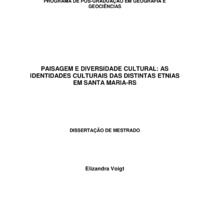-
Título
-
PAISAGEM E DIVERSIDADE CULTURAL: AS IDENTIDADES CULTURAIS DAS DISTINTAS ETNIAS EM SANTA MARIA-RS
-
lista de autores
-
ELIZANDRA VOIGT
-
Resumo
-
A cultura é considerada um conceito chave para a Geografia, ou seja, fundamental para explicar a relação que o homem estabelece com a paisagem e sua influência na materialidade do espaço. A presente pesquisa tem como objetivo geral analisar a diversidade étnica, através de seus códigos culturais materializados no município de Santa Maria-RS, identificando as distintas temporalidades e espacialidades expressas na paisagem. Os objetivos específicos buscaram: (a) compreender a inserção de diversas etnias em Santa Maria considerando suas temporalidades; (b) identificar na paisagem do município os códigos culturais e suas formas simbólicas estruturantes; (c) analisar as espacialidades atuais que remetem ao conjunto de expressões das distintas etnias presentes em Santa Maria. A relevância da pesquisa justifica-se pela importância dos estudos referentes à temática cultural, demonstrando às possibilidades de materialização das culturas inseridas no espaço local. Neste sentido, alguns questionamentos fazem-se pertinentes, ou seja, indaga-se como evoluíram as diferentes culturas via descendência em um espaço multicultural? Se os seus descendentes conseguiram manter seus hábitos, se houveram transformações ou até o abandono de alguns códigos culturais? Como essas culturas materializaram-se no espaço santa-mariense? Se alguns grupos étnicos ressignificaram seus códigos culturais? Essas foram questões que mediaram as reflexões realizadas ao longo do trabalho. Metodologicamente a pesquisa foi estruturada em etapas. Na fase inicial, realizou-se a operacionalização dos conceitos básicos da temática investigativa, bem como, a definição pelo método dialético. Tal opção se justifica pelo entendimento da realidade como um processo em permanente dinâmica e transformação. Definidas as matrizes teórico-metodológicas, a segunda etapa, se constituiu em levantamentos de dados em fontes secundárias. Paralelamente, buscou-se resgatar fotografias que materializem a contribuição dos imigrantes para a organização espacial de Santa Maria. A terceira fase esteve relacionada ao trabalho de campo, com intuito de observar in loco a materialidade das culturas no espaço santa-mariense. O trabalho de campo procurou evidenciar os aspectos culturais, presentes na paisagem, ou seja, aqueles que contêm a marca cultural , expressas através dos códigos das etnias presentes. Nesse sentido, a seleção das culturas, a serem estudadas tiveram como critério a sua importância para a organização espacial e a relevância histórica e econômica das mesmas para a gênese e evolução de Santa Maria. Nesta perspectiva, aliando os conceitos aos dados coletados e a observação in loco, procurou-se compreender e analisar a inserção das distintas etnias no contexto local, considerando a perspectiva cultural, bem como, entender a sua contribuição para a organização espacial, resgatando as temporalidades inerentes a evolução cultural santa-mariense.
-
Abstract
-
Culture is considered a key concept for Geography, that is, fundamental to explain the relationship that man establishes with landscaping and his influence on spatial materiality. This research seeks to analyze the ethnic diversity through their cultural codes embodied in the city of Santa Maria-RS, identifying the different temporalities and spatialities expressed in the landscape. The specific objectives were to: (a) understand the insertion of various ethnicities in Santa Maria considering their temporalities, (b) identify the city landscape and its cultural codes structuring symbolic forms, (c) analyze the current spatiality that refer to the set of expressions of distinct ethnic groups present in Santa Maria. The relevance of the research can be justified by the importance of studies regarding the cultural theme, demonstrating the possibilities of materialization of cultures embedded in the local space. In this regard, some questioning is relevant, such as, how did the cultures evolve via descendence in a multi-cultural space? Whether their descendants managed to keep their habits, or were there changes or even abandoning of some cultural codes? How did these cultures materialize in forementioned city? Did some ethnic groups redefine their cultural codes? These were questions that mediated the discussions held along the work. Methodologically the research was structured in stages. In the initial stage, there was the operationalization of the basic concepts of investigative theme, as well as the definition of the dialectical method. This choice is justified by the understanding of reality as a dynamic and ongoing process transformation. Once the theoretical-methodological matrices were defined, the second step consisted on surveying data from secondary sources. At the same time, we attempted to rescue photographs that materialize the contribution of immigrants to the spatial organization of Santa Maria. The third phase was related to field work, in order to observe in situ the materiality of cultures in Santa Maria. The fieldwork sought to highlight the cultural aspects present in the landscape, i.e., those which contain the "cultural mark", expressed through codes of ethnicities present. Accordingly, the selection of cultures to be studied had as a criterion their importance for the spatial organization and the historical and economic relevance to the genesis and evolution of Santa Maria. Thus, combining the concepts and the data collected on-site observation, we sought to understand and analyze the integration of different ethnic groups in the local context, considering the cultural perspective, as well as to understand their contribution to the spatial organization, rescuing the temporalities inherent cultural evolution of the city in question.
-
Palavras Chave
-
CULTURA
-
PAISAGEM CULTURAL
-
ETNIAS
-
ORGANIZAÇĂO DO ESPAÇO
-
SANTA MARIA-RS
-
Key Words
-
CULTURE
-
CULTURAL LANDSCAPE
-
ETHNICITIES
-
SPATIAL ORGANIZATION
-
SANTA MARIA-RS
-
Tipo
-
MESTRADO
-
Universidade
-
UNIVERSIDADE FEDERAL DE SANTA MARIA
-
Data
-
2013
-
Páginas
-
200
-
Localização
-
Biblioteca Digital de Teses e Dissertações (BDTD UFSM)
-
Orientador
-
MERI LOURDES BEZZI
-
Programa
-
Programa de Pós-Graduação em Geografia e Geociências
-
Sigla Universidade
-
UFSM
-
Área de Concentração
-
ANÁLISE AMBIENTAL E TERRITORIAL DO CONE SUL
-
Língua
-
Português
-
email
-
ELIZANDRAVOIGT@YAHOO.COM.BR
 VOIGT, ELIZANDRA.pdf
VOIGT, ELIZANDRA.pdf